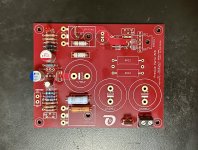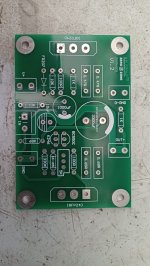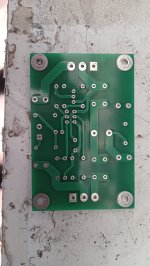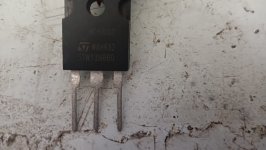Hi@Eric
The attached aca16 mods file is correct. Almost all of the parts are simple substitutions. C101 is an extra part that may be soldered on top of R12. Adding R16 requires a careful trace cut. There are several examples of how this was done by other builders. These days I would probably leave R5 and R6 at 100 Ohms.
As I worked more with the ACA, I found that substituting IRFP140 Mosfets for Q1 and Q2 sounded better as well. The other big improvement is building a linear power supply to provide 28V to 30V power rail. This can be done with a single 300VA transformer with two 24V or 25V secondary windings. I used 26MB40A block rectifiers and a CRCRC filter for each channel and found that a single amp built this way sounded better than either of the two bridged amp configurations.
Regarding alternate Mosfets: While the FQH44N10 parts were still in production, several of us found them to be superior to even the IRFP140, especially when using higher voltage power rails. Surplus parts occasionally show up online, but caution is advised to avoid Chinese fakes. The next best bet would be the IRFP048 Mosfets that are sold in the store as part of the F6 transistor kit.
I have finally created my own PCB and also the thump stopper. Thanks to Mr Pass and Tungsten Audio for everything.
Below are a few pictures, both PCB have been tested and are working great. Drop me a PM if you want the Gerbers files.
The first pic is showing the almost completed ACA monobloc amp 😀. My outputs are FQH44N10.
Yep, same heatsink as my monobloc VFET.
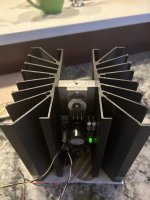
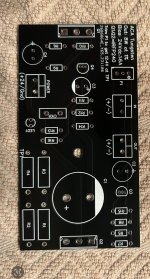
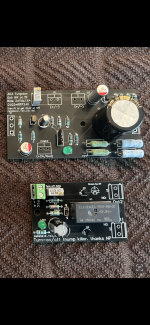
Eric
This post was rather timely. I dusted off one of my old ACA builds in the DH-220 chassis a couple days ago. The second rev of the F6 Diamond PCBs aren't due until early next week, and the shark needs to keep swimming..
I have been working with an early board design from RR, before they went off the rails with excessive amounts of hardware crammed onto the board. The boards I have at least convinced me that the use of integrated 3-pin regulators was not an improvement, even when the LT1084 might look good on paper. Turns out that Papa has a paper that talks about voltage regulation in power amplifiers in which he concludes that the use of an integrated regulator requires the same amount of filter capacitance before and bulk storage capacitance after the regulator as would be used in a passive linear filter. Yes, Class A amps are picky about their power supply.
The new PCB pictured above looks like a good, versatile design that will work with the standard 24V SMPS bricks as well as higher voltage supplies with appropriate adjustments. Following a re-tweak of the CRCRC filtration in my ACA-220, I am getting 29.5V delivered to the amp circuits. Bias current is running at 1.65A, and Drain voltage on Q1 is set to 15.25V. The chassis gets plenty warm, but not too hot. The boards currently in use still have the IRFP140 Mosfets at both Q1 and Q2. That was where I left the experimentation prior to becoming involved with the first of the DIY Sony VFET amps. The FQH44N10 devices were regarded highly by several builders who tried them. There seemed to be split preferences on whether the amps sounded better with the IRFP or the FQH part at Q2. Clearly the preference is up to the builder and their system.
For my part, I have enjoyed listening to the tweaked amp at modest volumes with my newer Vandersteens. The mods I used were originally voiced on the older model 2C speakers, and I have since upgraded to the 3A Signatures. The larger speakers are somewhat more demanding of power, yet the ACA still proves to be very capable and enjoyable to listen to with a variety of music.
For recent ACA builders who may not have access to the FQH44N10, there is good news. My work with the F6 has indicated that the IXTQ75N10P is an excellent alternative. Its high transconductance characteristic seems to be effective even at lower voltage than the FQH44N10. The IXTQ part does have a higher gate threshold voltage and will need about 1V extra Vgs than either the FQH or IRFP parts. The ACA may accommodate this by increasing R9 from 1k to 1.2k. I would use the IRFP140 at Q2 and leave R5 and R6 at 100 Ohms. The amp might be voiced differently by changing R6 to 68 Ohms after the amp has had ample time to burn in.
I have been working with an early board design from RR, before they went off the rails with excessive amounts of hardware crammed onto the board. The boards I have at least convinced me that the use of integrated 3-pin regulators was not an improvement, even when the LT1084 might look good on paper. Turns out that Papa has a paper that talks about voltage regulation in power amplifiers in which he concludes that the use of an integrated regulator requires the same amount of filter capacitance before and bulk storage capacitance after the regulator as would be used in a passive linear filter. Yes, Class A amps are picky about their power supply.
The new PCB pictured above looks like a good, versatile design that will work with the standard 24V SMPS bricks as well as higher voltage supplies with appropriate adjustments. Following a re-tweak of the CRCRC filtration in my ACA-220, I am getting 29.5V delivered to the amp circuits. Bias current is running at 1.65A, and Drain voltage on Q1 is set to 15.25V. The chassis gets plenty warm, but not too hot. The boards currently in use still have the IRFP140 Mosfets at both Q1 and Q2. That was where I left the experimentation prior to becoming involved with the first of the DIY Sony VFET amps. The FQH44N10 devices were regarded highly by several builders who tried them. There seemed to be split preferences on whether the amps sounded better with the IRFP or the FQH part at Q2. Clearly the preference is up to the builder and their system.
For my part, I have enjoyed listening to the tweaked amp at modest volumes with my newer Vandersteens. The mods I used were originally voiced on the older model 2C speakers, and I have since upgraded to the 3A Signatures. The larger speakers are somewhat more demanding of power, yet the ACA still proves to be very capable and enjoyable to listen to with a variety of music.
For recent ACA builders who may not have access to the FQH44N10, there is good news. My work with the F6 has indicated that the IXTQ75N10P is an excellent alternative. Its high transconductance characteristic seems to be effective even at lower voltage than the FQH44N10. The IXTQ part does have a higher gate threshold voltage and will need about 1V extra Vgs than either the FQH or IRFP parts. The ACA may accommodate this by increasing R9 from 1k to 1.2k. I would use the IRFP140 at Q2 and leave R5 and R6 at 100 Ohms. The amp might be voiced differently by changing R6 to 68 Ohms after the amp has had ample time to burn in.
C-R-L-C-R-L-C (??)
Might be able to find inductors whose (inductance, series resistance) parameters, in combination with the resistors and capacitors you've chosen, give sufficiently low Q (sufficiently high Zeta) such that resonances are overdamped and negligible. It's a pretty standard second order differential equation with a standard Laplace canonical solution.
Might be able to find inductors whose (inductance, series resistance) parameters, in combination with the resistors and capacitors you've chosen, give sufficiently low Q (sufficiently high Zeta) such that resonances are overdamped and negligible. It's a pretty standard second order differential equation with a standard Laplace canonical solution.
Here is an example of the ACA boards I am currently working with.
These include the last portion of the CRCRC filter that I use. The original filter caps were just 10,000 uF, but there are newer 15,000 uF parts available now that fit into the 25mm dia footprint. There is an option to use either a pair of 0.22 Ohm resistors or an inductor with a resistor in parallel to control the Q factor. Note that the unused regulator footprint needs to be bypassed by wires.
I will be using a Nichicon KG "Gold Tune" series 5600 uF cap in place of the 4700 uF output coupling cap. Just trying to keep the lower cutoff frequency well below the point where it might introduce phase anomalies with lower impedance speakers. It's not a big difference.
A pair of these boards will go into the same chassis that I recently tweaked. These should still run at 1.65A bias current with 29.5V power at the Drain of Q2.
These include the last portion of the CRCRC filter that I use. The original filter caps were just 10,000 uF, but there are newer 15,000 uF parts available now that fit into the 25mm dia footprint. There is an option to use either a pair of 0.22 Ohm resistors or an inductor with a resistor in parallel to control the Q factor. Note that the unused regulator footprint needs to be bypassed by wires.
I will be using a Nichicon KG "Gold Tune" series 5600 uF cap in place of the 4700 uF output coupling cap. Just trying to keep the lower cutoff frequency well below the point where it might introduce phase anomalies with lower impedance speakers. It's not a big difference.
A pair of these boards will go into the same chassis that I recently tweaked. These should still run at 1.65A bias current with 29.5V power at the Drain of Q2.
Attachments
What sort of power would you get out of such a setup ....with that rail Vdc and the Iq. And is it happy into 4r load? Big old heatsinks I guess, assuming the RACAM led heatsinks won't cut it!
Yes, replacing 4700uF with 5600 uF will reduce the LF rolloff frequency by 16%. { math: 100 * (1 - (4700 / 5600)) = -16.1% }
In the equal tempered scale used to tune modern pianos, that's a quarter of an octave. Three semitones.
In the equal tempered scale used to tune modern pianos, that's a quarter of an octave. Three semitones.
Hello and Happy New Year everyone. I have two pcbs from Aliexpress, as I will show you below, but the schematic is somewhat different from anything I found online. An FR207 diode appears and the 2k21 resistor is missing. Does anyone know this variation? I also have 4 STW13NB60 transistors and I would like to know if I can mount them here. Thank you in advance and I wish you much health and happiness!!
I think you can either solder a link in the position of the diode or that would be a convenient place for a resistor in case you want to increase the supply voltage and limit the voltage across the input jfet.
The 2k2 resistor you'll have to solder yourself according to the schematic. Not difficult at all.
Just check the build guide somewhere here on this site.
I also think you can use that power fet although it's a high voltage device with a rather high Ciss. Maybe someone else will chime in with a more educated opinion.
Cheers
The 2k2 resistor you'll have to solder yourself according to the schematic. Not difficult at all.
Just check the build guide somewhere here on this site.
I also think you can use that power fet although it's a high voltage device with a rather high Ciss. Maybe someone else will chime in with a more educated opinion.
Cheers
Last edited:
The STW13NB60 has a high Vgs, called the gate threshold. This will make it difficult for the ACA circuit to achieve the right bias current. The high gate capacitance Ciss may prevent the amp from sounding good, even if can be biased with enough current. If you can find IRFP240 or IRFP140, those would be much better.
Buying Zero Zone boards from Aliexpress is an unfortunate choice. Zero Zone has a bad reputation for making poor copies of Nelson Pass amplifiers. Aliexpress does not offer support for the products they sell.
Buying Zero Zone boards from Aliexpress is an unfortunate choice. Zero Zone has a bad reputation for making poor copies of Nelson Pass amplifiers. Aliexpress does not offer support for the products they sell.
It is almost a 240 in to220 of 125w instead of 150w and knowing that each one is going to dissipate at most 30w, I see it well. It's true?
I might want to add, as the output capacitor is enclosed within the feedback loop in this case, the improvement will be a better DF at low frequencies not so much an improvement in bandwith.Yes, replacing 4700uF with 5600 uF will reduce the LF rolloff frequency by 16%. { math: 100 * (1 - (4700 / 5600)) = -16.1% }
In the equal tempered scale used to tune modern pianos, that's a quarter of an octave. Three semitones.
Where can I find such heatsinks? Thx!
My updated ACA boards are happily playing in the Hafler chassis. The power settled in at 29.7 V with 1.65 Amp bias current. Drain voltage on Q1 is 15.35 V. I used an IRFP140 at Q2 and the IXTQ75N10P at Q1.
With only a few hours on the new configuration, music from the amp is remarkably clear and dynamic. Bass has better extension and overall balance. Music has sense of ease and flow with a variety of recordings. Aspects of the sound remind me of the F6 Diamond that recently got the same IXTQ75N10P Mosfets. Of course the F6 plays louder, but the ACA comes surprisingly close.
With only a few hours on the new configuration, music from the amp is remarkably clear and dynamic. Bass has better extension and overall balance. Music has sense of ease and flow with a variety of recordings. Aspects of the sound remind me of the F6 Diamond that recently got the same IXTQ75N10P Mosfets. Of course the F6 plays louder, but the ACA comes surprisingly close.
- Home
- Amplifiers
- Pass Labs
- ACA amp with premium parts
